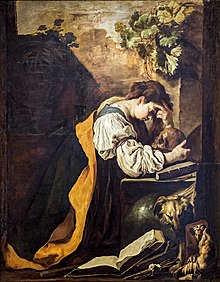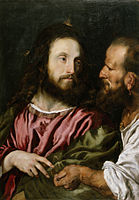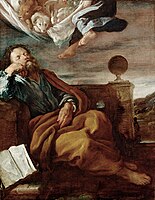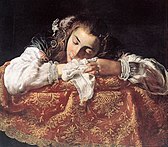Domenico Fetti
Domenico Fetti | |
|---|---|
 | |
| Born | c. 1589 Rome, Italy |
| Died | 16 April 1623 (Aged 33-34) |
| Known for | Painting |
| Movement | Baroque |
| Patron(s) | Duke Ferdinando I Gonzaga |


Domenico Fetti (also spelled Feti) (c. 1589 – 16 April 1623) was an Italian Baroque painter who was active mainly in Rome, Mantua and Venice.
Biography
[edit]Born in Rome to a little-known painter, Pietro Fetti, Domenico is said to have apprenticed initially under Ludovico Cigoli, or his pupil Andrea Commodi in Rome from circa 1604–1613. He then worked in Mantua from 1613 to 1622, patronized by the Cardinal, later Duke Ferdinando I Gonzaga. In the Ducal Palace, he painted the Miracle of the Loaves and Fishes. The series of representations of New Testament parables he carried out for his patron's studiolo gave rise to a popular speciality,[1] and he and his studio often repeated his compositions.[2]
In August or September 1622,[3] his feuds with some prominent Mantuans led him to move to Venice, which for the first few decades of the seventeenth century had persisted in sponsoring Mannerist styles (epitomized by Palma the Younger and the successors of Tintoretto and Veronese). Into this mix, in the 1620s–30s, three "foreigners"—Fetti and his younger contemporaries Bernardo Strozzi and Jan Lys—breathed the first influences of the Roman Baroque style. They adapted some of the rich colouration of Venice but adapted it to Caravaggio-influenced realism and monumentality.[4]
In Venice, where he remained despite pleas from the Duke to return to Mantua, Fetti changed his style: his formalized painting style became more colourful. In addition, he devoted attention to smaller cabinet pieces that adapt genre imaging to religious stories. His group of paintings entitled Parables, which represent New Testament scenes, are at the Dresden Gemäldegalerie. He influenced Leonaert Bramer.
His painting style appears to have been influenced by Rubens. He would likely have continued to find excellent patronage in Venice had he not died there in 1623 or 1624. Jan Lys, eight years younger, but who had arrived in Venice nearly contemporaneously, died during the plague of 1629–30. Subsequently, Fetti's style would influence the Venetians Pietro della Vecchia and Sebastiano Mazzone. His pupils in Mantua were Francesco Bernardi (il Bigolaro) and Dionisio Guerri.[5] He also instructed his sister Lucrina in painting, and her works have sometimes been attributed to him.
Gallery
[edit]-
Portrait of an Actor (c. 1621–1622)
-
Ideal Portrait of Gonzaga (c. 1620)
-
Christ and the Tribute Money (c. 1618–1620), a copy of The Tribute Money by Titian
-
Peter's vision of a sheet with animals (c. 1619)
-
David with the Head of Goliath (c. 1610–1620)
-
Veronica's Veil (1618 or 1622)
-
The Young David Gathering Stones for his Slingshot
-
The Repentant St Mary Magdalene (c. 1617–1621)
-
Sleeping Girl (c. 1615)
Works
[edit]Fetti's works include:
- The Good Samaritan (Metropolitan Museum of Art, New York)
- Melancholy (Accademia, Venice)
- Emperor Domitian (Louvre)
- Eve and Laboring Adam (Louvre)
- Angel in the Garden (Louvre)
- Jacob's Dream (Kunsthistorisches Museum, Vienna)
- Portrait of an Actor (Hermitage Museum, St Petersburg)
- The Healing of Tobit (Hermitage Museum, St Petersburg)
References
[edit]- ^ Pamela Askew, "The Parable Paintings of Domenico Fetti." Art Bulletin 43 (1961:31–32], reprinted in Seventeenth Century Art in Italy, France and Spain (The Garland Library of the History of Art 8). New York, 1976.
- ^ Some examples: The Good Samaritan, attributed to Fetti himself, ca 1618–22 (Metropolitan Museum of Art), repetitions by Fetti are in Boston and Dresden, as well as studio repetitions; Parable of the Mote and the Beam, attributed, ca 1619 (Metropolitan Museum); Parable of Lazarus and the Rich Man, workshop, ca 1618–1628 (National Gallery of Art, Washington DC).
- ^ Askew 1978.
- ^ See Alfred Moir, The Italian Followers of Caravaggio. 2 vols. (Harvard University Press) 1967.
- ^ Le vite de' pittori, degli scultori, et architetti veronesi, by Bartolomeo Dal Pozzo (1718), page 169.
- Wittkower, Rudolf (1993). Pelican History of Art, Art and Architecture Italy, 1600–1750. Penguin Books. pp. 106–107.
 Herbermann, Charles, ed. (1913). "Domenico Feti". Catholic Encyclopedia. New York: Robert Appleton Company.
Herbermann, Charles, ed. (1913). "Domenico Feti". Catholic Encyclopedia. New York: Robert Appleton Company.- Askew, Pamela (1954). Domenico Fetti. London.
External links
[edit]![]() Media related to Paintings by Domenico Fetti at Wikimedia Commons
Media related to Paintings by Domenico Fetti at Wikimedia Commons










